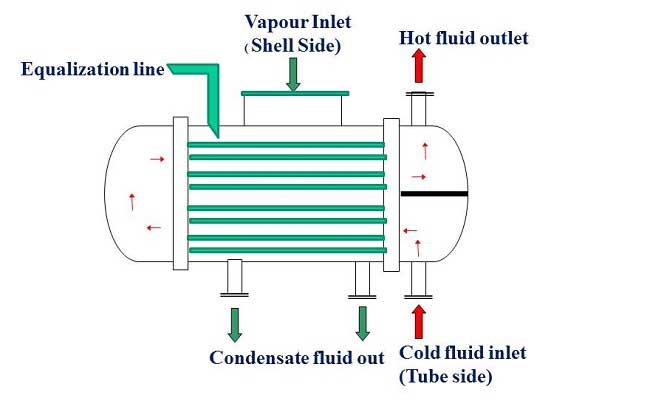In this article described about the water requirement calculation for condenser, difference between direct contact and surface condenser & Types of surface condenser and its application
Condenser Water Requirement Calculation | Types of Surface Condensers
In sugar Industry Condensers and cooling systems are used in boiling process to create vacuum in pans and evaporators.
The principle of condenser is based on the transmission of heat content in the vapour to the cooling or injection water. The quantity of the cooling water necessary for condensation of vapour is found by equating the heat given up by the vapour in condensing to the heat absorbed by the cold water.
Where
W = weight of the cooling water in kg/kg of vapour to be condensed
Total heat of the vapour in kcal/kg,
To = Temperature of the hot water leaving the condenser
Ti = Temperature of the cold water entering the condenser
Main Classification of Condensers
The steam condensers may be broadly classified into the following two types, depending upon the way in which the steam is condensed.
1. Direct Contact condenser (or) Jet condenser (or) Mixing type condenser
2. Surface condensers ( or) non-mixing type condensers.
Direct Contact or Jet Condensers:
Direct contact condensers are commonly used for condensing the vapour in evaporators and vacuum pans. In this condensers, where the cooling water comes into direct contact with the vapour to be condensed.
For complete information regarding the this type of condenser please go through the below link
Types of Direct Contact Condenser System with design criteria for vacuum creations and condensation of vapour
Surface Condenser:
A surface condenser has a great advantage over the direct contact condensers, as the condensate does not mix with the cooling water. As a result of this, whole condensate can be reused in the system.
This type of condenser is essential in ships, which can carry only a limited of fresh water for the boilers. It is also widely used in land installations, where inferior water is available or the better quality of water for feed is to be used economically.
Surface condenser consists of a horizontal cylindrical vessel packed with tubes, through which the cooling water flows, the ends of the condenser are cut off by vertical perforated type plates into which water tubes are fixed.
It consists of longitudinal section with number of passes. The water passes through the tubes and steam passes through shell side of the condenser.
Steam Condenser in thermal power plants
A steam condensers is a closed vessel into which the steam is exhausted and condensed after doing work in on engine cylinder or turbine. A steam condenser has the following two objects.
1 . The primary object is to maintain a low pressure (below atmospheric pressure) so as to obtain the maximum possible energy from steam and thus to secure a high efficiency.
2. The secondary object is to supply pure feed water to the hot well, from where it is pumped back to the boiler.
Types of Surface Condensers:
The surface condensers may be further classified on the basis of the direction of the condensate, the arrangement of tubing system and the position of the extraction pump into following four types.
1. Down flow surface condenser.
2. Central flow surface condenser.
3. Regenerative surface condenser.
4. Evaporator condenser
Down flow condenser
In down flow condenser the steam enters at the top and flow downwards over the tubes due to force of gravity as well as suction of the extraction pump fitted at the bottom. The condensate is collected at the bottom and then pumped by the extraction pump. The dry air pump suction pipe, which is provided near the bottom, is covered by baffle so as to prevent the condensed steam into it as shown in figure. As the steam flow perpendicular to the direction of flow of cooling water (inside the tubes) this is called cross surface condenser.
Central flow surface condenser:
In central flow surface condenser, the exhaust steam enters at the top and flow downward. The suction pipe of the air is placed in the center of the tube nest. This causes the steam to flow radically inwards over the tubes towards the suction pipe. The condensate is collected at the bottom and the pumped by extraction pump. The central flow surface condenser is an improvement over the down flow type as the steam is directed radially inwards by a volute casting around the tube nest. It tubes gives an access to the whole periphery of the tubes.
Evaporative condenser:
The steam to be condensed enters at the top of a series of pipes outside of which is a film of cold water. At the same time, a current of air circulates over the film, causing rapid evaporation of some of the cooling water. As a result of this the steam circulating inside the pipe is condensed. The remaining cooling water is collected at an increased temperature and is reused, its original temperature is restored by the addition of the requisite quantity of cold water.
This condenser consists of filled piping, which is bent back and forwards and in a vertical plane.
Regenerative surface condensers:
In regenerative surface condenser, the condensate is heated by a regenerative method. The condenser after the tubes is passed through the exhaust from the engine (or) turbine.
Difference between surface condenser and jet condenser
| S.NO | Surface Condenser | Jet or Direct Contact Condenser |
| 1 | Steam and Cooling water are not mixed up. | Cooling water and steam are mixed up |
| 2 | More suitable for high capacity plants. | Less suitable for high capacity plants. |
| 3 | Condensate is reused. | Condensate is wasted |
| 4 | It requires large quantity of circulating water. | It requires less quantity of circulating water |
| 5 | The condensing plant is costly and complicated. | Condensing plant is economical and simple |
| 6 | Its maintenance cost is high. | Its maintenance cost is low. |
| 7 | Less power is required for air pump. | More power is required for air pump. |
| 8 | Less power is required for waste pumping | High power is required for water pumping |
Related Articles
Pump Power Calculation Formula | Specific speed of a centrifugal pump
Heat Transfer Coefficient of Liquid -Liquid Tubular Heater Calculation| HTC
Overall heat transfer coefficient for shell and tube heat exchanger


5 thoughts on “Surface Condenser | Difference Between Jet Condenser and Surface Condenser”
Amrendra kumar singh
(October 22, 2018 - 1:38 am)It is nice super idea for incrising condensate recovery.
siva alluri
(October 23, 2018 - 3:07 pm)Thank you Mr.Amrendra kumar singh
winarno
(August 13, 2022 - 5:32 am)sir, i want to know drawing & picture surface condensor, can’t you help me?
June Soto
(January 12, 2023 - 9:07 am)Hello. Thank you for always good blog
HPS Bhatia
(May 24, 2023 - 11:08 am)Sir,
Normally Condensers are used in power plants with Steam Turbines with cooling towers & water is recirculated in Sugar Industry.
I need following informations pl.
1 Air cooled condensers can be used with power plant if so where being used.
2 Can Air cooled condensers be utilised instead of cooling towers in the process section of sugar plant,if so where it is working pl.
Main purpose is to reduce the water consumption & requirement.
Thanks & regards.